Influence of Graphene Nanoplatelets and Post-Curing Conditions on the Mechanical and Viscoelastic Properties of Stereolithography 3D-Printed Nanocomposites
Abstract
:1. Introduction
2. Materials and Methods
2.1. Materials
2.2. Sample Preparation
2.3. Characterization Methods
3. Results and Discussion
3.1. Three-Dimensionally Printed Photopolymer and Its Nanocomposites
3.2. Viscoelastic Properties
3.3. Thermal Properties
3.4. Mechanical Properties of 3D-Printed Photopolymer Nanocomposites
4. Conclusions
- (1)
- This study conclusively demonstrates that the integration of graphene nanoplatelets (xGNP) into SLA 3D-printed photopolymer nanocomposites significantly improves the mechanical and viscoelastic properties. The addition of xGNP ensures a significant improvement in the elastic modulus, hardness, and storage modulus through its reinforcing effect, which independently contributes to the performance of the printing material. Post-curing, particularly at high temperatures, maximizes these properties even further by increasing the cross-linking density. While post-curing is critical to achieving the highest mechanical performance, the fundamental role of xGNP addition is equally important.
- (2)
- The incorporation of up to 0.25 wt% graphene nanoplatelets resulted in exceptional improvements, with elastic modulus and hardness increasing by 104% and 85%, respectively, compared to control samples. These improvements are primarily due to the uniform distribution and strong interaction of graphene within the photopolymer matrix, which also significantly improves viscoelastic properties, especially the storage modulus.
- (3)
- Furthermore, the study reveals that by optimizing post-curing conditions such as UV curing and thermal curing at 160 °C, further tuning of these properties is possible by controlling the cross-linking density. The results highlight the innovative potential of graphene nanoplatelets to improve the performance of 3D-printed materials while highlighting the importance of post-processing techniques for achieving optimal material properties. This dual approach of xGNP integration and optimized post-cure enables the production of high-performance 3D-printed components, positioning this work at the forefront of advanced materials development for industries where improved mechanical properties are essential.
5. Future Scope
Author Contributions
Funding
Institutional Review Board Statement
Data Availability Statement
Acknowledgments
Conflicts of Interest
References
- Iftekar, S.F.; Aabid, A.; Amir, A.; Baig, M. Advancements and Limitations in 3D Printing Materials and Technologies: A Critical Review. Polymers 2023, 15, 2519. [Google Scholar] [CrossRef] [PubMed]
- Senthooran, V.; Weng, Z.; Wu, L. Enhancing Mechanical and Thermal Properties of 3D-Printed Samples Using Mica-Epoxy Acrylate Resin Composites—Via Digital Light Processing (DLP). Polymers 2024, 16, 1148. [Google Scholar] [CrossRef] [PubMed]
- Mamo, H.B.; Adamiak, M.; Kunwar, A. 3D printed biomedical devices and their applications: A review on state-of-the-art technologies, existing challenges, and future perspectives. J. Mech. Behav. Biomed. Mater. 2023, 143, 105930. [Google Scholar] [CrossRef] [PubMed]
- Schittecatte, L.; Geertsen, V.; Bonamy, D.; Nguyen, T.; Guenoun, P. From resin formulation and process parameters to the final mechanical properties of 3D printed acrylate materials. MRS Commun. 2023, 13, 357–377. [Google Scholar] [CrossRef]
- Hisham, M.; Dileep, C.; Jacob, L.; Butt, H. Additive manufacturing of carbon nanocomposites for structural applications. J. Mater. Res. Technol. 2024, 28, 4674–4693. [Google Scholar] [CrossRef]
- Khan, Z.I.; Habib, U.; Mohamad, Z.B.; Tufail, A.; Raji, A.M.; Khan, A.U. Innovative hybrid nanocomposites of recycled polyethylene terephthalate/polyamide 11 reinforced with sepiolite and graphene nanoplatelets. J. Thermoplast. Compos. Mater. 2024, 1–26. [Google Scholar] [CrossRef]
- Jyoti, J.; Singh, B.P. A review on 3D graphene–carbon nanotube hybrid polymer nanocomposites. J. Mater. Sci. 2021, 56, 17411–17456. [Google Scholar] [CrossRef]
- Dai, G.; Mishnaevsky, L. Graphene reinforced nanocomposites: 3D simulation of damage and fracture. Comput. Mater. Sci. 2014, 95, 684–692. [Google Scholar] [CrossRef]
- Hanon, M.M.; Ghaly, A.; Zsidai, L.; Szakál, Z.; Szabó, I.; Kátai, L. Investigations of the mechanical properties of dlp 3d printed graphene/resin composites. Acta Polytech. Hungarica 2021, 18, 143–161. [Google Scholar] [CrossRef]
- Tsang, C.H.A.; Zhakeyev, A.; Leung, D.Y.C.; Xuan, J. GO-modified flexible polymer nanocomposites fabricated via 3D stereolithography. Front. Chem. Sci. Eng. 2019, 13, 736–743. [Google Scholar] [CrossRef]
- Bustillos, J.; Montero-Zambrano, D.; Loganathan, A.; Boesl, B.; Agarwal, A. Stereolithography-based 3D printed photosensitive polymer/boron nitride nanoplatelets composites. Polym. Compos. 2019, 40, 379–388. [Google Scholar] [CrossRef]
- Markandan, K.; Lai, C.Q. Enhanced mechanical properties of 3D printed graphene-polymer composite lattices at very low graphene concentrations. Compos. Part A Appl. Sci. Manuf. 2020, 129, 105726. [Google Scholar] [CrossRef]
- Lai, C.Q.; Markandan, K.; Luo, B.; Lam, Y.C.; Chung, W.C.; Chidambaram, A. Viscoelastic and high strain rate response of anisotropic graphene-polymer nanocomposites fabricated with stereolithographic 3D printing. Addit. Manuf. 2021, 37, 101721. [Google Scholar] [CrossRef]
- Luo, Z.; Yang, Z.; Fei, Z.; Li, K. Effect of crosslinking rate on the glass transition temperature of polyimide cross-linked silica aerogels. J. Polym. Res. 2020, 27, 255. [Google Scholar] [CrossRef]
- Thiessen, M.; Abetz, V. Influence of the glass transition temperature and the density of crosslinking groups on the reversibility of diels-alder polymer networks. Polymers 2021, 13, 1189. [Google Scholar] [CrossRef]
- Díez-Pascual, A.M.; Gómez-Fatou, M.A.; Ania, F.; Flores, A. Nanoindentation in polymer nanocomposites. Prog. Mater. Sci. 2015, 67, 1–94. [Google Scholar] [CrossRef]
- Wang, C.; Gong, H.; Wu, H.; Jin, Q.; Wei, W.; Liang, J.; Lu, B.; Chen, S.; Long, Y. Optimized sintering strategy for lunar regolith simulant particles bound via vat photopolymerization. Mater. Chem. Phys. 2023, 297, 127393. [Google Scholar] [CrossRef]
- Menard, K.P.; Menard, N. Dynamic Mechanical Analysis, 3rd ed.; CRC Press: Boca Raton, FL, USA, 2020. [Google Scholar]
- Sun, Y.; Yu, A.; Liang, Y.; Wang, G.; Song, S.; Lu, W.; He, Z.; Meng, S. Crosslink density and mechanical property evolution during the curing of polyurethane-urea/sodium silicate hybrid composites. High Perform. Polym. 2022, 34, 66–76. [Google Scholar] [CrossRef]
- Korčušková, M.; Svatík, J.; Tomal, W.; Šikyňová, A.; Vishakha, V.; Petko, F.; Galek, M.; Stalmach, P.; Ortyl, J.; Lepcio, P. Anatase and rutile nanoparticles in photopolymer 3D-printed nanocomposites: Band gap-controlled electron interactions in free-radical and cationic photocuring. React. Funct. Polym. 2024, 200, 105923. [Google Scholar] [CrossRef]
- de Armentia, S.L.; Fernández-Villamarín, S.; Ballesteros, Y.; de Real, J.C.; Dunne, N.; Paz, E. 3D Printing of a Graphene-Modified Photopolymer Using Stereolithography for Biomedical Applications: A Study of the Polymerization Reaction. Int. J. Bioprinting 2022, 8, 182–197. [Google Scholar] [CrossRef]
- Abbaspour, S.; Alijanvand, S.H.; Morshedi, D.; Shojaosadati, S.A. Inhibitory effect of plain and functionalized graphene nanoplateles on hen egg white lysozyme fibrillation. Colloids Surfaces B Biointerfaces 2023, 230, 113487. [Google Scholar] [CrossRef] [PubMed]
- Zhu, Y.; Su, L.; Deng, J.; Liang, M.; Xu, C.; Jiao, Y.; Chen, Y.; Yao, Z. Impact of GNP content on cure behaviors and diverse properties of epoxy composites modified with graphene nanoplatelets: A comprehensive study. Mater. Today Commun. 2023, 37, 107014. [Google Scholar] [CrossRef]
- Lopez de Armentia, S.; Abenojar, J.; Ballesteros, Y.; del Real, J.C.; Dunne, N.; Paz, E. Polymerization Kinetics of Acrylic Photopolymer Loaded with Graphene-Based Nanomaterials for Additive Manufacturing. Nanomaterials 2022, 12, 4498. [Google Scholar] [CrossRef] [PubMed]
- Hang, Z.; Yu, H.; Lu, Y.; Huai, X.; Luo, L. Effect of graphene carbon nitride on ultraviolet-curing coatings. Materials 2020, 13, 153. [Google Scholar] [CrossRef]
- Wang, X.; Blechert, S.; Antonietti, M. Polymeric Graphitic Carbon Nitride for Heterogeneous Photocatalysis. ACS Catal. 2012, 2, 1596–1606. [Google Scholar] [CrossRef]
- Bayarsaikhan, E.; Lim, J.-H.; Shin, S.-H.; Park, K.-H.; Park, Y.-B.; Lee, J.-H.; Kim, J.-E. Effects of Postcuring Temperature on the Mechanical Properties and Biocompatibility of Three-Dimensional Printed Dental Resin Material. Polymers 2021, 13, 1180. [Google Scholar] [CrossRef]
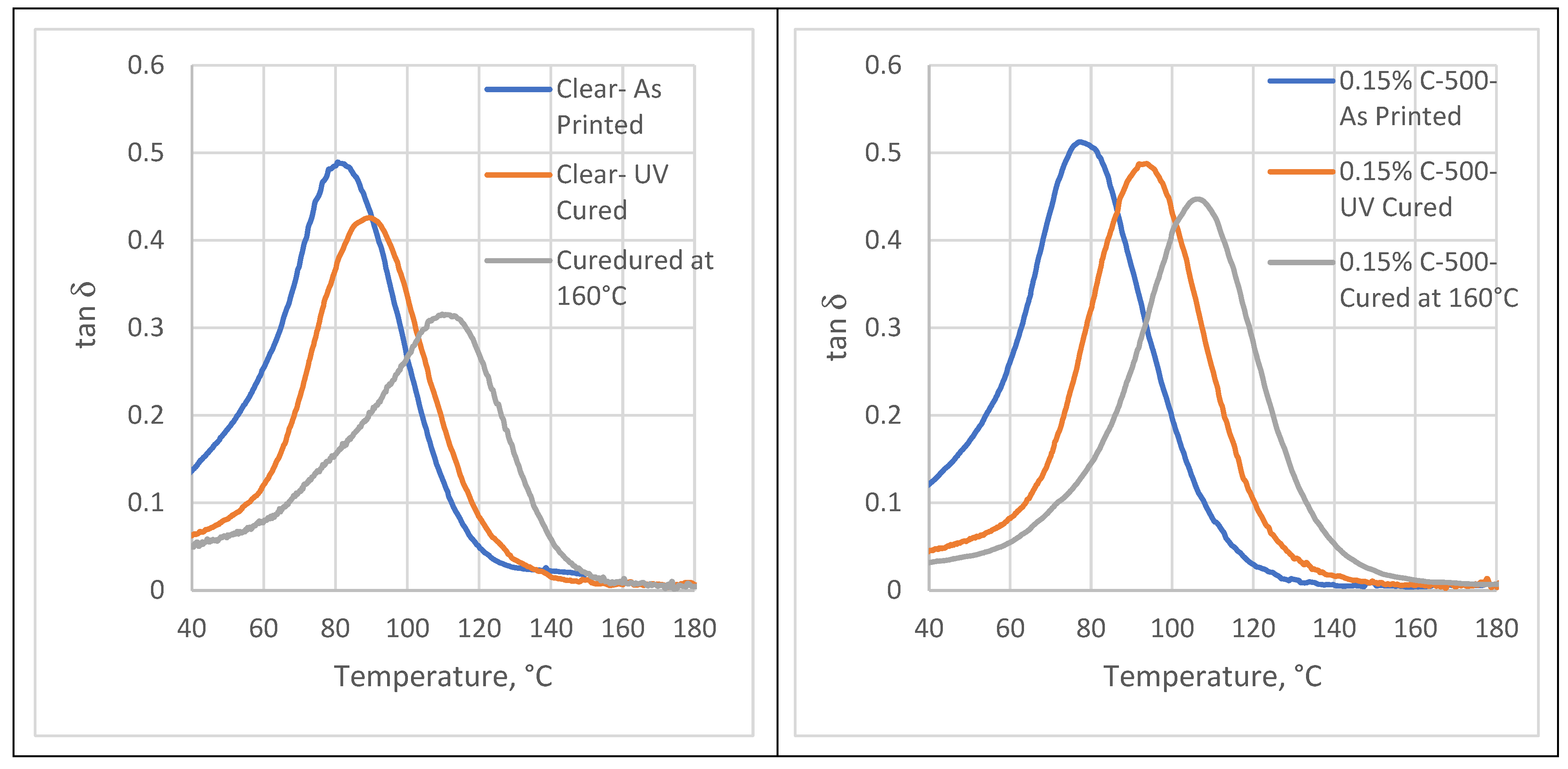
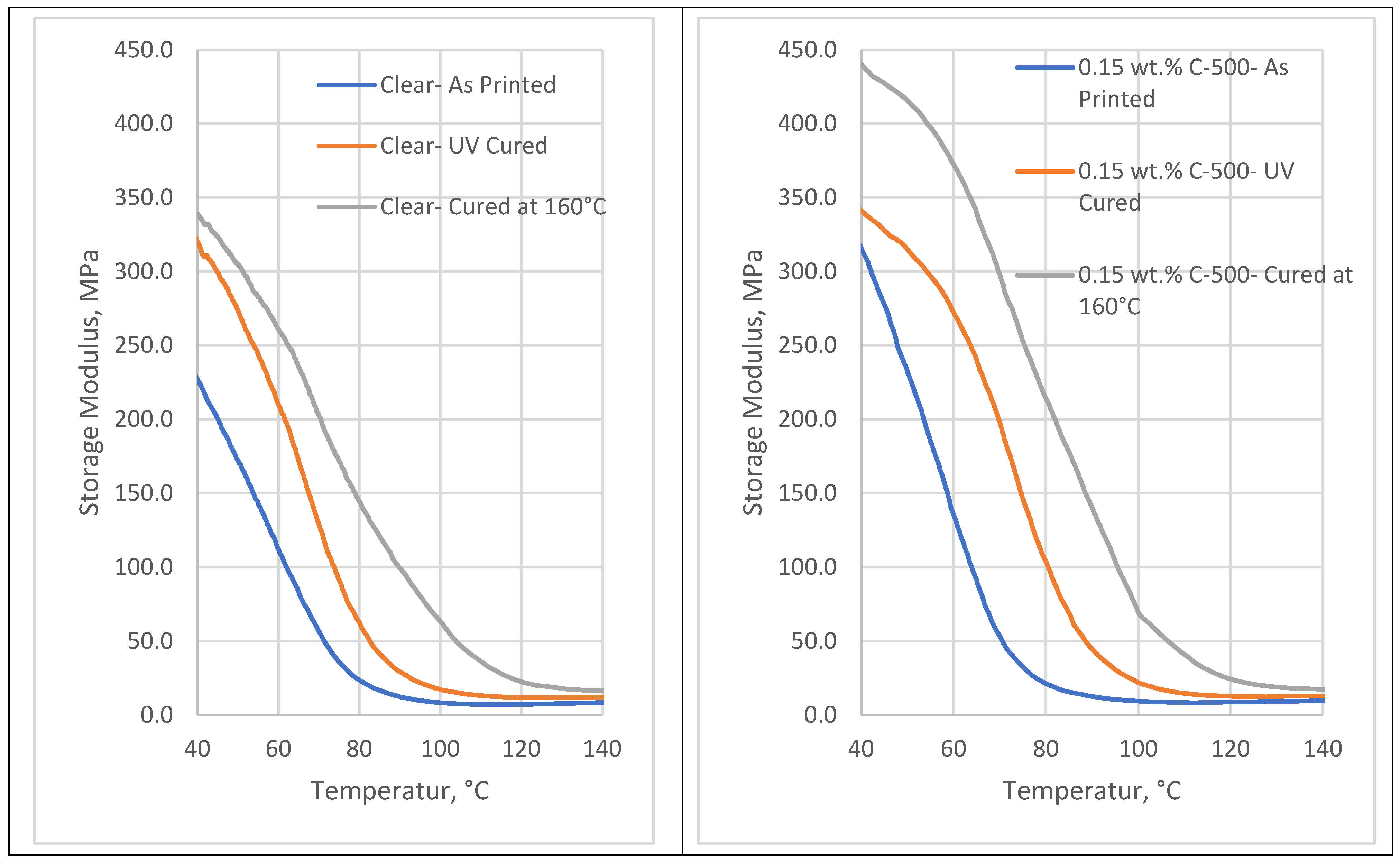
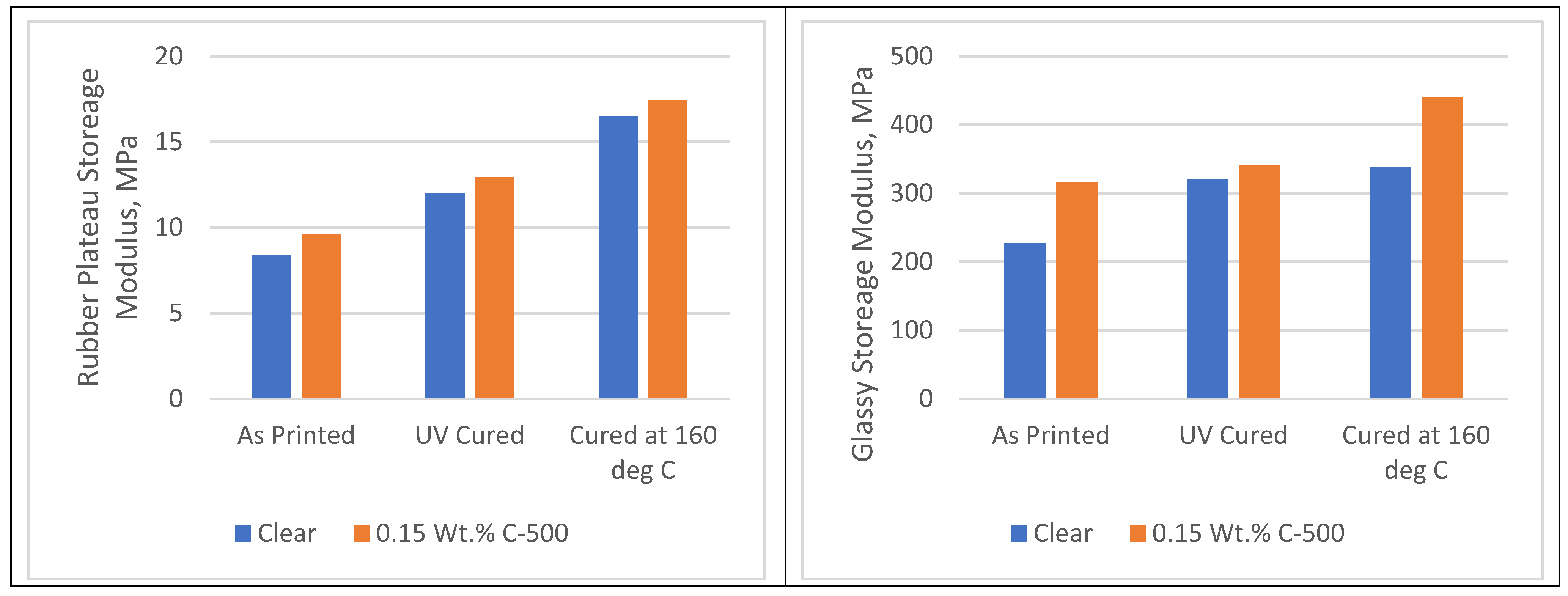

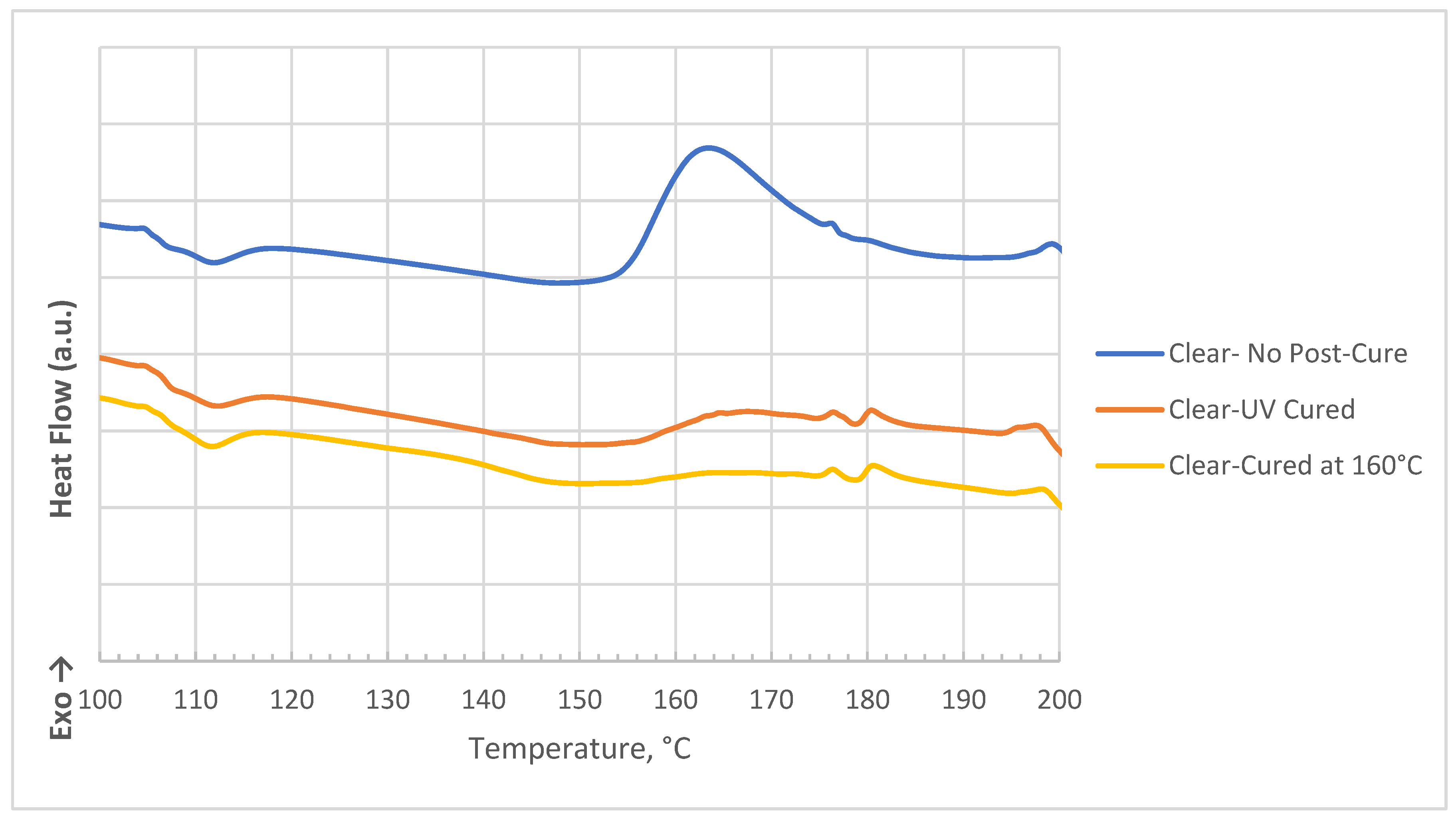
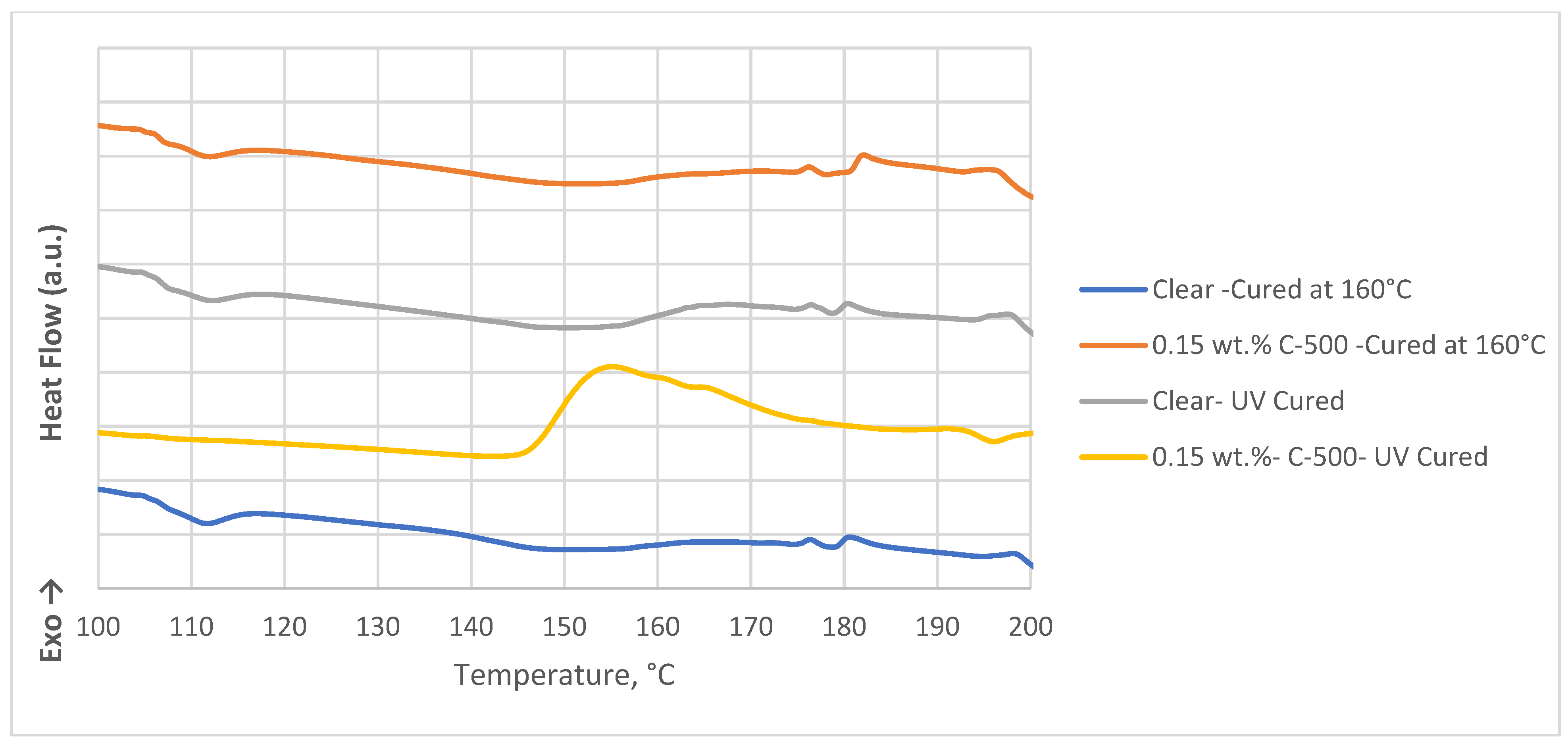



| Formulations | Rubbery Modulus (MPa) | Glassy Modulus (MPa) | Cross-Link Density (mol/m3) |
|---|---|---|---|
| Clear-As Printed | 8.42 ± 0.30 | 226.94 ± 8.00 | 816.9 ± 20 |
| Clear-UV Cured | 12.00 ± 0.40 | 320.12 ± 10.00 | 1164.7 ± 25 |
| Clear-Cured at 160 °C | 16.51 ± 0.50 | 338.67 ± 12.00 | 1602.3 ± 30 |
| 0.15 wt%C-500-As Printed | 9.63 ± 0.35 | 315.87 ± 9.00 | 934.6 ± 22 |
| 0.15 wt%C-500-UV Cured | 12.95 ± 0.45 | 341.01 ± 11.00 | 1256.5 ± 26 |
| 0.15 wt%C-500-Cured at 160 °C | 17.43 ± 0.55 | 440.06 ± 14.00 | 1691.5 ± 35 |
| Formulations | Initial Temperature (Ti) [°C] | Peak Temperature (Tp) [°C] | Final Temperature (Tf) [°C] | Heat of Curing (ΔH) [J/g] |
|---|---|---|---|---|
| Clear | 110 | 145 | 160 | 220 |
| 0.05 wt% C-500 | 115 | 150 | 170 | 240 |
| 0.10 wt% C-500 | 118 | 155 | 175 | 250 |
| 0.15 wt% C-500 | 120 | 160 | 180 | 260 |
| 0.25 wt% C-500 | 125 | 165 | 185 | 270 |
Disclaimer/Publisher’s Note: The statements, opinions and data contained in all publications are solely those of the individual author(s) and contributor(s) and not of MDPI and/or the editor(s). MDPI and/or the editor(s) disclaim responsibility for any injury to people or property resulting from any ideas, methods, instructions or products referred to in the content. |
© 2024 by the authors. Licensee MDPI, Basel, Switzerland. This article is an open access article distributed under the terms and conditions of the Creative Commons Attribution (CC BY) license (https://creativecommons.org/licenses/by/4.0/).
Share and Cite
Ahmad, K.H.; Mohamad, Z.; Khan, Z.I. Influence of Graphene Nanoplatelets and Post-Curing Conditions on the Mechanical and Viscoelastic Properties of Stereolithography 3D-Printed Nanocomposites. Polymers 2024, 16, 2721. https://doi.org/10.3390/polym16192721
Ahmad KH, Mohamad Z, Khan ZI. Influence of Graphene Nanoplatelets and Post-Curing Conditions on the Mechanical and Viscoelastic Properties of Stereolithography 3D-Printed Nanocomposites. Polymers. 2024; 16(19):2721. https://doi.org/10.3390/polym16192721
Chicago/Turabian StyleAhmad, Khalid Haj, Zurina Mohamad, and Zahid Iqbal Khan. 2024. "Influence of Graphene Nanoplatelets and Post-Curing Conditions on the Mechanical and Viscoelastic Properties of Stereolithography 3D-Printed Nanocomposites" Polymers 16, no. 19: 2721. https://doi.org/10.3390/polym16192721







